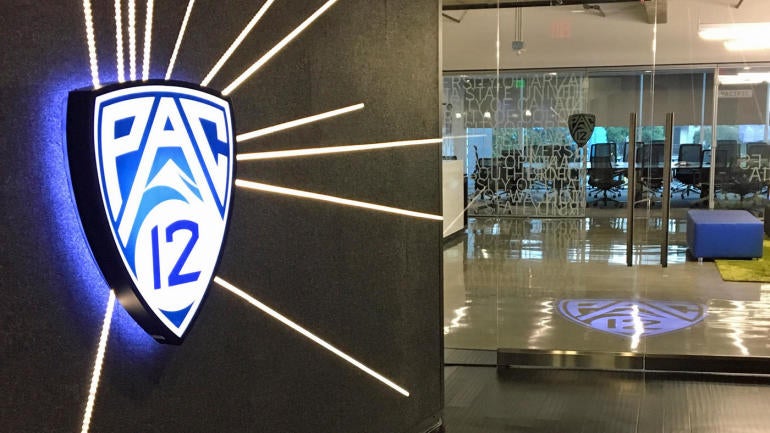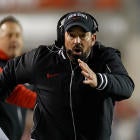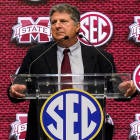
LOS ANGELES -- Less than two months into his administration, Pac-12 commissioner George Kliavkoff never thought he'd field a question about his conference being vulnerable to realignment. But he did not shy away from it.
"There are no guarantees in life," Kliavkoff told CBS Sports.
While college sports wonders whether there will be a total reset of the competitive and financial models, for now, the talking points have come down to the statuses of a precious few schools. There are four pieces left on the board, per se, that approach the value of Texas and Oklahoma: Ohio State, Michigan, Notre Dame and USC.
Ohio State and Michigan have no interest in leaving the Big Ten. Currently the richest, oldest conference in existence, it is paying members approximately $54 million per year.
Until further notice, Notre Dame is locked into its independence. The one-year football venture into the ACC was intriguing but remains a one-off caused by COVID-19. However, per its contractual agreement with the ACC, it is locked in to joining the conference should it want to move anywhere through 2036. But the Fighting Irish already have their own network (NBC), that ACC football scheduling agreement, increased access to the proposed 12-team College Football Playoff and perhaps the best brand in the game. Why share?
That leaves USC. The Trojans have options. USC has one of the most recognizable brands in sports. It resides in the nation's second-biggest television market. It possesses desirable academics and athletics. It would likely enhance any conference's media rights contract.
USC could remain in the Pac-12, strike out on its own as an independent or join another league -- with or without partners from the Pac-12.
"We're listening [to what's going on elsewhere]," a high-profile USC official told CBS Sports. "We're just trying to listen and learn like everybody else."
Clearly, that's not a firm commitment that USC is staying put. But why would any school with options declare its loyalty so early? Look at the windfall run into by Texas and Oklahoma.
The remark from that USC official highlights Kliavkoff's immediate focus as a new round of realignment begins: secure the conference by securing USC first.
Lately, the commissioner has been letting a lot of calls go to voicemail.
"I have taken the stance that we're not going to be reactively poaching any schools," Kliavkoff said. "What I will say is that my phone has exploded the last five days [after the Texas/Oklahoma news broke]. Blown up. We are having inbounds from lots and lots of schools.
"I would not be doing my job … if I didn't take and understand and evaluate those opportunities to add schools."
Kliavkoff and Big 12 commissioner Bob Bowlsby met Tuesday to discuss whether an alignment between the two conferences makes sense going forward, sources tell CBS Sports. There are a number of options up for discussion between the two Power Five big-wigs, ranging from a simple scheduling alliance to something more drastic like a merger between the leagues.
This after a report emerged last week that Texas Tech had reached out to the Pac-12 directly despite the eight remaining Big 12 schools appearing to be united for now.
Industry sources tell CBS Sports there is no combination of remaining Big 12 schools that would bring value to the Pac-12.
The Big 12 remains the only Power Five conference with a smaller membership than the Pac-12. Does staying at 12 teams make the Pac-12 more vulnerable now that the Texas-Oklahoma move has begun rumblings about the emergence of four "superconferences"?
"You have to be strategic," Oregon athletic director Rob Mullens said. "Number [of teams] is one piece of the strategy, but you have to think big. I'm not ready to make a definitive answer on a number yet."
Stack these Power Five implications in whatever order, but they all impact the Pac-12's future and will have to be addressed soon:
The ACC is stuck with an under-value media rights contract ($32.4 million per school) despite signing it just five years ago. Unless the league somehow gets Notre Dame to join or is part of a mega merger with the Big Ten or Pac-12, it will be last in Power Five revenue until 2036. The deal was originally longer but was shortened at the ACC's request, sources tell CBS Sports. Industry sources speculate that ESPN got long-term cost certainty in exchange for allowing the ACC to get its own linear cable network.
The Big 12 now has time to contemplate its future, but it can't stay at eight teams and retain sufficient playoff access and revenue. Sources indicate the Big 12 has leverage if it wants to make a move against the American Athletic Conference. The Big 12 has automatic New Year's Six access and -- as long as the league stays together to the end of the current contract in 2025 -- $37 million in annual media rights revenue. The AAC has neither.
The Big Ten doesn't have to make a move. Remember the value of Ohio State and Michigan. The league's footprint already contains a quarter of the United States population. Plus, the Big Ten is seemingly in line for a significant TV revenue bump when its current contract with ESPN and Fox expires in 2023. Former commissioner Jim Delany was wise enough to sign only a six-year deal in 2017 so his conference could get to the open market ahead of the Big 12 and Pac-12. Any speculation about adding Pac-12 schools to the Big Ten starts with those additions bringing at least $60 million worth of annual value to the Big Ten contract. (That's assuming even a conservative increase in the Big Ten's current deal in 2023.)
What once looked like a lucrative media rights contract negotiated by former Pac-12 commissioner Larry Scott now looks outdated. The Pac-12 Network never reached its expected distribution levels. Conference schools make $32 million annually in media rights revenue. That's $22 million less than Big Ten schools and approximately $28 million less than SEC schools will make when their new deal commences in 2024. Oklahoma and Texas will likely make equal shares as it's unknown whether ESPN would be open to renegotiating the deal.
It's safe to say the Pac-12 can't wait until the end of its current media rights deal in 2024 to make a move. The collection of West Coast schools still has value because of their "hegemony," according to a veteran of media rights negotiations. The combination of the Los Angeles, Phoenix, Denver and Seattle TV markets is significant. That source added that there was no value in any current Power Five conference "stretching" across the country to get Pac-12 schools.
"When you're in our conference, you have a golden ticket," Kliavkoff said. "People don't give up golden tickets.
"If that decision [to leave] is made, it's for short-term financial gain, which by the way, I think would be a long-term financial loss. It would be made giving up everything else our conference brings."
That's good news for those speculating about a Big Ten reach to the West Coast. However, there is a combination of four Pac-12 schools out there (including USC) that would be a good academic and athletic fit for the Big Ten.
"Historically, USC has had a close nexus with Stanford, UCLA, Washington," said a veteran source with USC ties. "Academic and athletic success. I don't see [USC] vacating the West Coast. Where would they go? It's just so far to travel."
As we've learned in realignment, there are no absolutes. Expect the unexpected.
No one knew until negotiations were way down the line that Scott was attempting to lure six Big 12 schools to his conference 11 years ago. The shock became real when Texas and Oklahoma left for the SEC last week.
Kliavkoff would not answer when asked directly whether the Pac-12 had formed an expansion committee to study the landscape.
"It's not the hardest question; it's an easy one to answer," he said. "I'm just not going to answer it."





















